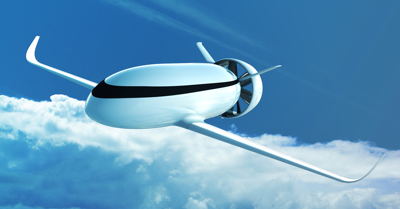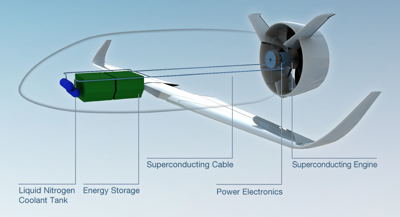Superconducting motors could power all-electric aircraft
At the recent Paris Air Show, the aerospace group EADS unveiled a concept design for an electrically-powered aircraft that would use superconducting motors to drive co-axial, counter-rotating, shrouded propellers at the rear of the aircraft. But the ultra-quiet, zero-emission aircraft, called VoltAir, is unlikely to take to the skies before 2030 at the earliest.

“VoltAir is an upstream research concept, not a near-term commercial approach”, says EADS’ chief technical officer, Jean Botti. “As a systems architect for aircraft, we are pushing the envelope in this research to stimulate new ideas. The objective here is to push the envelope to move towards more electric, emission-free propulsion.”
Although conventional motors can be highly efficient, they do not offer the power densities (energy output per unit weight) required to power large aircraft. But motors incorporating “high-temperature” superconducting (HTS) materials are expected to exceed the power densities of gas turbines in future. These motors can be cooled to superconducting temperatures using low-cost, environmentally-friendly liquid nitrogen.
EADS expects HTS motors to reach power densities of 7–8kW/kg with almost no electrical losses, making them suitable for use in the VoltAir. Current turboshaft engines achieve power densities of 7kW/kg.
In flight, the VoltAir will not emit any carbon dioxide or nitrous oxide. Only small amounts of harmless nitrogen will be vented after being used to cool the motors and the superconducting cables that carry power from batteries housed in containers in the hold.
When the aircraft lands, these battery containers will be replaced in a similar way to loading and unloading cargo or luggage containers. By keeping all battery recharging and maintenance operations on the ground, on-board weight and complexity will be reduced. EADS says the aircraft will be “repowered” at least as quickly as conventional refuelling.

One reason that the VoltAir is unlikely to fly for at least two decades, is that battery energy densities will need to improve dramatically to make all-electric flight feasible. But EADS believes that the demand for batteries for electric and hybrid vehicles could lead to systems with the necessary energy densities, possibly based on lithium-air or lithium-sulphur technologies. Within 20 years, these batteries are expected to achieve energy densities of at least 1kWh/kg, more than doubling today’s performance and making the VoltAir a practical possibility.
Although the batteries will still weigh more than an equivalent amount of kerosene fuel, the fact that the energy storage system weight will not change during flight has advantages for aircraft designers. For example, it will allow them to locate batteries at the front of the aircraft, away from its centre of gravity and balancing the weight of the propulsion system at the rear of the fuselage. The absence of wing-mounted engines and landing gear will result in efficient, aerodynamically clean wings with undisturbed airflows.
To maximise efficiency, the propellers in the shrouded propulsion system will ingest the wake from the fuselage.
The aircraft’s fuselage has been shaped to reduce noise levels caused by air flowing along the skin. Noise levels will be reduced further by locating the quiet electric motors downstream at the rear of the fuselage, away from the cabin. The cabin will have a wide cross-section compared to its length, giving a spacious feeling, and reducing boarding times.
EADS has produced videos explaining the VoltAir concept here and here.





